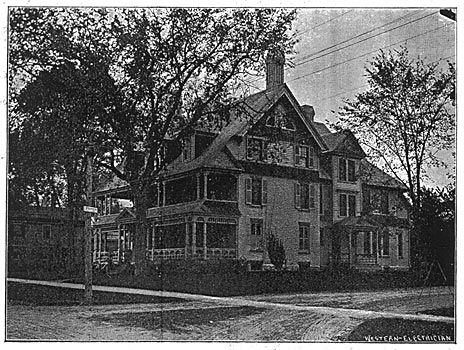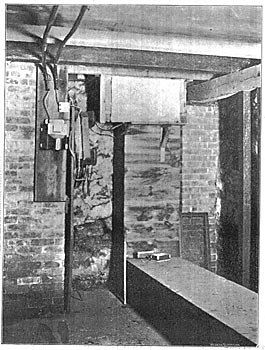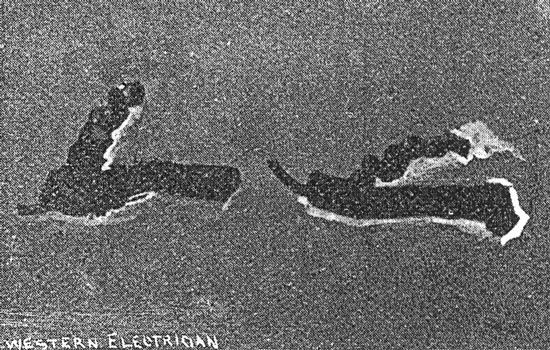[Trade Journal]
Publication: Western Electrician
Chicago, IL, United States
vol. 17, no. 17, p. 197-198, col. 1-3
Death of Franklin L. Pope.
Franklin Leonard Pope, patent solicitor, expert and electrical engineer, was instantly killed by electricity on Sunday, October 13th, in the cellar of Wainwright Hall, in the pretty village of Great Barrington, Massachusetts. In accordance with plans prepared several years ago, Mr. Pope had finally decided to make this his permanent home, and there he had gathered those volumes and records which are the jewels of the author and historian. Every possible modern convenience had been considered in connection with the equipment of this model home. Not satisfied, however, with the simple role of a customer of the local electric lighting company, the owner, having been appointed consulting engineer, had planned certain improvements involving an eventual reconstruction of the whole system. This work had already been completed so far as concerned the change from steam to water power, and the new line, about five miles in length, was connected to the old wires in the village and put into operation last spring. It was the intention to gradually replace the old distributing lines as rapidly as the resources of the company would permit. An alternating equipment was selected, and a voltage of 2,100 transformed down to 50 was adopted. In order to facilitate his observations of the working of the plant, Mr. Pope had permitted the installation of a transformer in the cellar of Wainwright Hall, to which the primary circuit was originally led through an underground loop. This had failed twice during thunder storms, and on the last occasion, in the absence of the owner, but with his permission, the wires were brought in overhead, as shown in Fig. 1, which is a view of the north gable of the house. Passing under the cellar window the loop entered, as shown in Fig. 2, which is an interior view of that portion of the compartment in which Mr. Pope met his death, at about half-past five o'clock. The window was obscured, as shown in the picture, by a sheet of paper, in order to obtain better results with a flash-light negative. The converters and meter are shown as they were at the time, but unfortunately the wires had been cut before the arrival of those who undertook an investigation.
Mr. Pope's son, Leonard, was sitting in the south parlor a little past five'o'clock on Sunday evening. He is a very intelligent youth of 15, and a close observer. He was reading a book, and as darkness approached he turned on a lamp. A spark jumped from the socket to his knuckle, giving a tingling shock up to the elbow. His father told him not to touch if again, but before the words were spoken he had turned it off. His father then turned on another lamp, carefully touching the rubber key only. He felt no shock, but the lamp was dim. Mr. Pope went out of the room, and the next that was known of him was the heavy fall and the crash of glass caused by the breaking of a lamp chimney. This unusual sound was heard by Anna, the oldest daughter, a bright and thoughtful girl of 19. She thought her brother had fallen, and as soon as she could light a lamp started down stairs, where she saw her father's head on the floor as she approached, and heard the gurgling sound caused by the relaxation of the muscles in cases of this kind. She called to her mother to bring water, and upon her arrival started on a run for Dr. Large, whose office is only about 300 yards away. The doctor responded at once to the call, and promptly undertook the work of resuscitation by artificial respiration, assisted by others then on the spot, and by Drs. Camp and Benjamin, who arrived a few minutes later. There was no hope, however, and the physicians were reluctantly forced to admit that death was instantaneous. There was at one time an impression that a severe bruise on the back of the head might have caused death. In order to remove all doubt, an autopsy was performed on Wednesday by Drs. Large, Small and Lane, which showed that the deceased had been in perfect health, and that the result of the fall in itself would not have been fatal.
HOW THE ACCIDENT PROBABLY OCCURRED.
Ralph W. Pope, secretary of the American Institute of Electrical Engineers and oldest surviving brother of Franklin Leonard Pope, returned to New York on Friday.
Mr. Pope, like his brother, has had a long and varied electrical experience, and, from the time of his arrival at Great Barrington on Monday up to his departure on Thursday, made a daily study of every condition existing at the spot where his brother died. He also carefully questioned every person who had any knowledge of the facts, as no official examination was made beyond the autopsy on Wednesday. Mr. Pope places great confidence in the careful examination of the converters, wires, etc., personally conducted by Edward Weston, William Stanley and George A. Hamilton, than whom, he says, no higher authority could be desired. These gentlemen have a report in preparation which will soon be published.
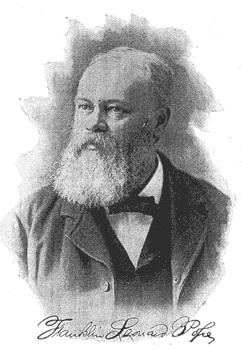 |
Mr. Pope's story of the occurrence shows that his brother was apparently the victim of an accident, solely due to the fact that in order to test the lines and observe the working of the plant he had permitted the location in his cellar of a converter, which necessitated the leading in of the primary wires of the system, carrying a normal voltage of 2,100. These wires were brought in at the north cellar window at a point about two feet from the transformer. There was a twisted joint in each wire about midway between the entrance of the primaries and the converter to which they were connected. One of the joints stuck up, and although. both were supposed to be covered with so-called insulating tape, it is quite possible that one of the points of these joints was bare, owing to the difficulty of covering such a joint unless extreme care is used. The tape from these joints had been removed after the accident and the wire adjacent to the joints themselves broken on one side and cut with pliers on the other. The joints, Fig. 3, were taken out and were found On the floor behind the cold air box on Thursday. One of the facts which an early examination did not account for was that the main scar on the right hand gave evidence of a mechanical injury, being a deep ragged scratch, as well as a scar from the electrical burn. (See Fig. 4.) The point of either of these joints was well calculated to produce such an injury. Two other minor burns, one on the knuckle and one on the back tip of the forefinger, might have been made either before or after the more serious injury.
As he approached the transformer with the lighted lamp in his left hand to look at the wires, it is possible that he first encountered a strong draft, from the open cellar window, the sash of which was suspended by hinges, but according to the statement of Mr. Bell, who was familiar with the cellar, had been unfastened for some time and would therefore swing more or less with the wind. It was necessary in order to secure it, to push the window back and at the same time turn the button on the end of the sash with his right hand. Having thus closed the window, the withdrawal of the hand apparently brought it into contact with one of the twisted joints already described, by which his body was placed in the primary circuit, the current entering his hand, passing through his body and entering the concrete floor through the soles of his shoes. It is quite likely that the flame of the kerosene lamp may have been blown out before Mr. Pope had closed the window, in which case the liability to an accident of this kind was increased, or some other trivial incident may have diverted his attention for a moment. It was a rainy day and he had walked to and from church, a distance of about half a mile, and had also strolled about his yard, so that his shoes were doubtless damp. The wet branches of trees swayed by the wind had also caused grounds on the main line through the village, the consequent flashing having been quite generally noticed that evening. Had he stood closely enough to the window to close and fasten it, he must have stood on a portion of the concrete floor dampened by the dripping of water from the wires, which had no "water-drip" outside.
Mr. Weston is of the opinion that the position of the hand after closing the window was at such an angle with the wire that the existing burn could not have been made by the point, although no other theory as to the raggedness of the injury has been advanced. It is evident that no attempt was made to handle the wires in any manner, all the burns being on the back of the hand.
FUNERAL OF MR. POPE.
The funeral of Mr. Pope was held at the house Wednesday afternoon, October 16th, and was largely attended. The Episcopal service was read by Rev. Dr. Hartley, and a quartette from the choir of St. James church chanted the responses. The commitment service at the grave was also read by Dr. Hartley. The bearers were Edward Manville, Parley A. Russell, Ward Lewis, Merritt I. Wheeler, C. H. Bell and J. P. Pomeroy. The honorary bearers were all electricians and warm personal friends of the deceased. They were Edward Weston, Newark, N. J.; Wm. Stanley, Pittsfield; Stephen D. Field; Stockbridge; James Hamblet, Brooklyn; George A. Hamilton, F. W. Jones, New York. Mr. Pope's brothers, Henry and Ralph Pope, and their families, M. F. Dickinson, Jr., and wife, Boston; Lieut. Walter Dickinson, U. S. A., Amherst; Asa W. Dickinson, Jersey City; Mrs. Lindsay, relatives of Mrs. Pope, were present at the funeral. Among those from out of town were President Whittlesey, of the Stanley Electric company; Mr. Gamwell of Pittsfield, Charles A. Terry, Nelson W. Perry, Robert H. Reid, Joseph Wetzler, Murray Carrington, New York; William Maver, Jr., Jersey City Heights.
BIOGRAPHICAL SKETCH.
Franklin Leonard Pope was identified with the electrical interests of this country since the early days of telegraphy, and he was acquainted with the history of the development of all branches. He has been termed the historian of the electrical work of this country. The excellent portrait of the deceased which accompanies this article will recall his kindly expression to his numerous friends.
| |||
| Fig. 1. Death of Franklin Leonard Pope. — North View of Residence Showing Wires Entering House. |
Franklin Leonard Pope was born in Great Barrington. December 2, 1840, in the house at the foot of Mt. Petra, now occupied by James Seymour. A few years after his birth his parents moved to the house in which he died. He was educated in the public schools of the town, and spent one term at the academy in Amherst. In 1848 a telegraph line was built from Bridgeport to Bennington, Vt., which passed through Great Barrington. Even at this early day young Pope evinced interest in its workings and in 1857, when a branch of the American Telegraph line was extended to Great Barrington, he was appointed operator. He was taught to operate the Hughes printing telegraph machine. About that time, in connection with two other school friends, he published a small amateur paper called the Berkshire Rambler. He remained in charge of the telegraph office for two years, when he was appointed circuit manager of the telegraph line along the Boston & Albany railroad, with headquarters at Springfield. Shortly afterward he went to New York, where he was employed as an artist on the Scientific American. During the war the demand for operators brought Mr. Pope back into the telegraph field. While stationed at Providence, during his leisure moments, he made a map of the telegraph service between New York and Boston. This map was seen by the engineer in-chief of the American Telegraph company, General Marshall Lefferts, and he transferred Mr. Pope to New York and subsequently employed him to make a complete series of maps of the company's system, which embraced all the lines of the seaboard states from Maine to Virginia. This work occupied his attention for nearly two years, and during that time he personally inspected the whole system. While engaged in this work the New York draft riots broke out and he was sent to repair the line between New York and Boston. He disguised himself as a farm laborer, and with a portable telegraph instrument and tools for repairing the wires concealed in a sack of oats he left New Rochelle at night and repaired a single wire from that place to the Harlem river before daylight, a distance of 16 miles, and succeeded in restoring communication.
| |||
| Fig. 2. Death of Franklin Leonard Pope. — Cellar Showing Converter and Meter Near Window. |
In 1864 Mr. Pope was appointed assistant engineer of the Russo-American Telegraph company. After arriving in San Francisco it was found that a portion of the proposed route had never been explored. Two parties were formed, and Mr. Pope was given command of one. In this expedition he was accompanied by his brother Ralph and Stephen D. Field of Stockbridge. In the company of George Blenkinsop of Victoria, B. C., they made the first exploration of the extensive region between the British Columbia border and Alaska, about the Skeena, Stickeen and Yukon rivers. After suffering the privations incidental to an Arctic winter, they finally reached the mouth of the Stickeen river, and found a trading vessel, which took them back to Victoria. They were absent one year. He was next ordered to Kamschatka, but before he could embark for that country the project of constructing a telegraph line from San Francisco to St. Petersburg, by way of Behring's Strait, was rendered useless by the successful laying of the Atlantic cable, and the enterprise was abandoned. On his return to New York Mr. Pope was retained as an expert and engineer in many electrical enterprises. It has been claimed that Edison's first business venture in the electrical world was in partnership with Mr. Pope, under the title of Pope & Edison, and that together they invented in 1870 the "ticker." Other inventions brought him prominently forward in the electrical field. He invented in 1872 the rail circuit for automatically controlling the electric block system now in general use on railways. He also patented many other improvements relating to railway and telegraphic service.
In 1886 he was elected president of the American Institute of Electrical Engineers, succeeding Dr. Norvin Green, and was for many years editor of the Electrical Engineer. He wrote "Modern Practice of the Electrical Telegraph" (1871) and "Life and Work of Joseph Henry" (1870). He was one of the first patent solicitors making electrical inventions a specialty, and for several years held the position of patent attorney for the Western Union Telegraph company. Of late years he has had much to do with the Westinghouse litigation, and his work on the development of the incandescent lamp is considered the most comprehensive history of the experiments in that line that has yet been published. The courts did not sustain Mr. Pope's view of the invention of the incandescent lamp, but the most earnest advocate of Mr. Edison's claims must admit that Mr. Pope made a strong case against him. It was as a writer on electrical topics that Mr. Pope was best known. His pleasing style and the earnestness which he displayed carried conviction with his arguments. At the last general meeting of the American Institute of Electrical Engineers he presented a paper on the Great Barrington electric lighting plant, and at that time comment was made in this journal on the excellent character of the article.
| |||
| Fig. 3. Death of Franklin Leonard Pope. — Joints From the Primary Loop. |
Mr. Pope was married to Miss Amelia Dickinson at Amherst, 1873. She is a sister of M. F. Dickinson, Jr., a prominent lawyer in Boston, Asa W. Dickinson of Jersey City, formerly a noted lawyer and politician, and Lieut. Walter Dickinson of the United States army, who is military instructor at the Agricultural College in Amherst. Besides a widow, deceased is survived by two daughters and a son. His brother, Ralph W. Pope, is secretary of the American Institute of Electrical Engineers. Another brother, Henry W. Pope, is connected with the American Telephone & Telegraph company of New York.
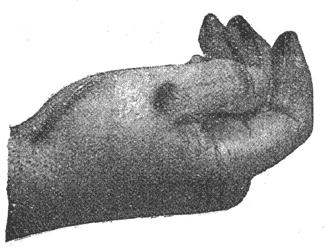 |
| Fig. 4. Death of Franklin Leonard Pope. — Showing Burns on Hand. |
BROOKLYN ELECTRICAL SOCIETY PAYS A TRIBUTE TO THE
LATE INVENTOR.
On October 15th the Brooklyn Electrical society met in the Edison assembly room at Brooklyn and adopted resolutions expressing the grief of the members upon the death of Franklin Leonard Pope, and extending to the family of the deceased assurances of the sympathy of the friends and associates of the late expert. A graceful tribute to his ability and character was also paid by the members.

